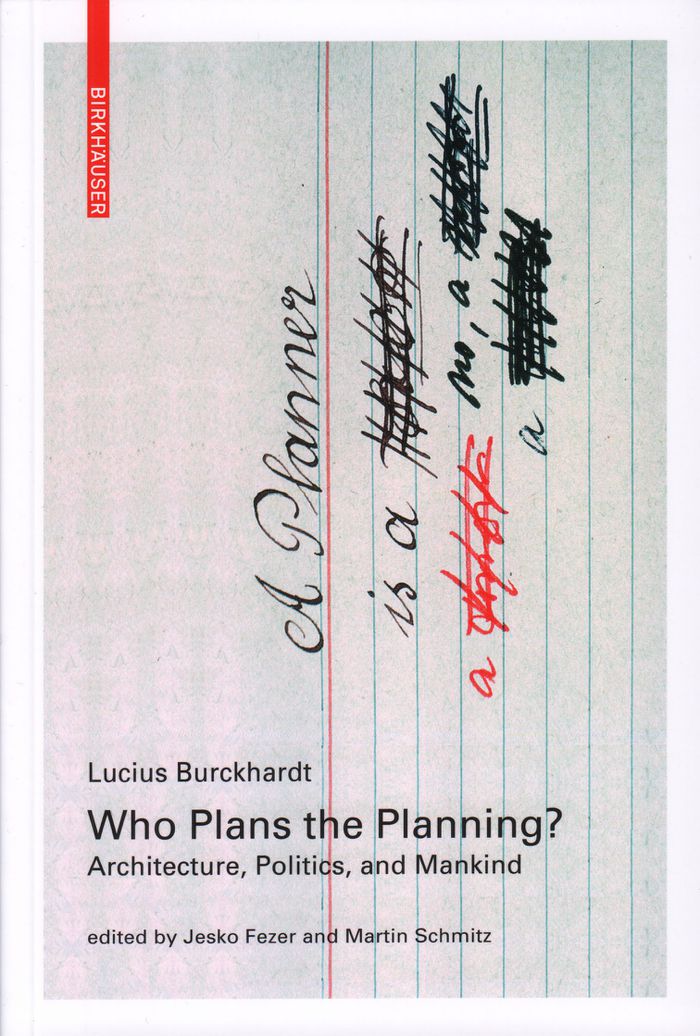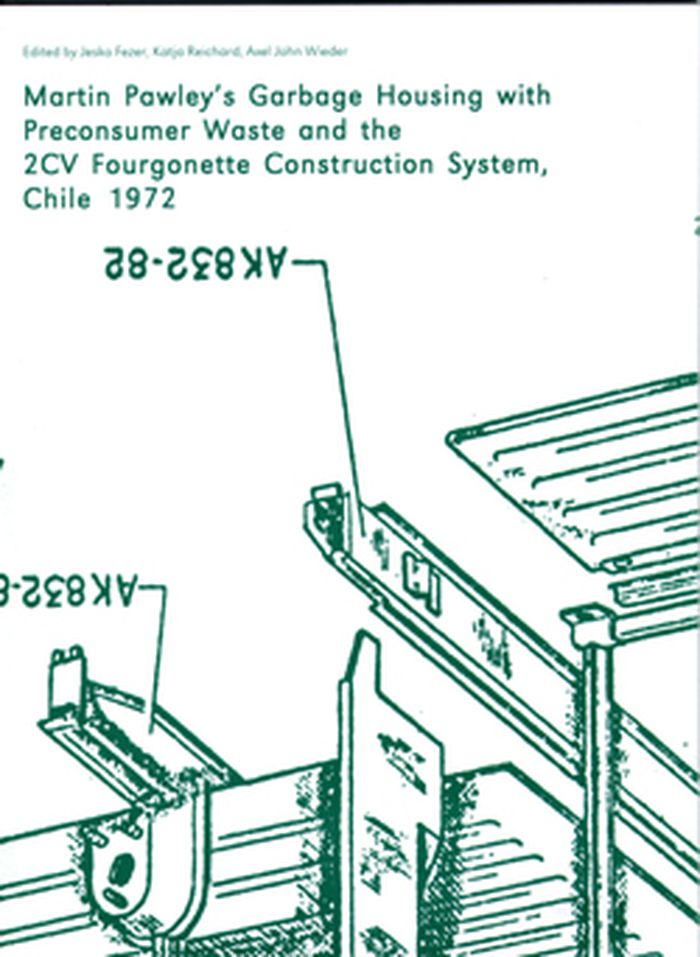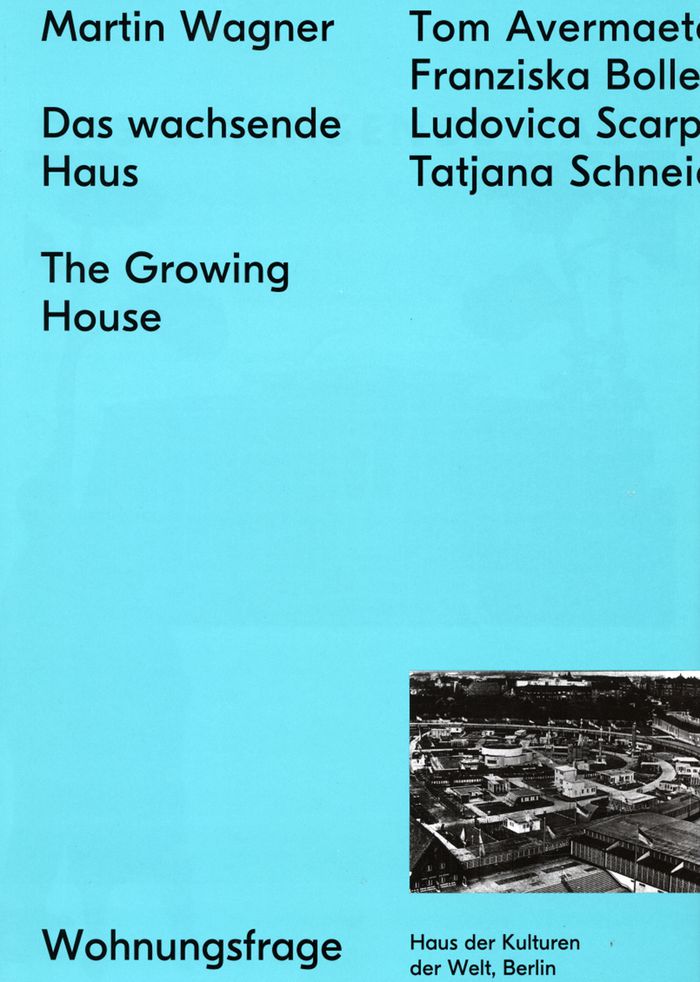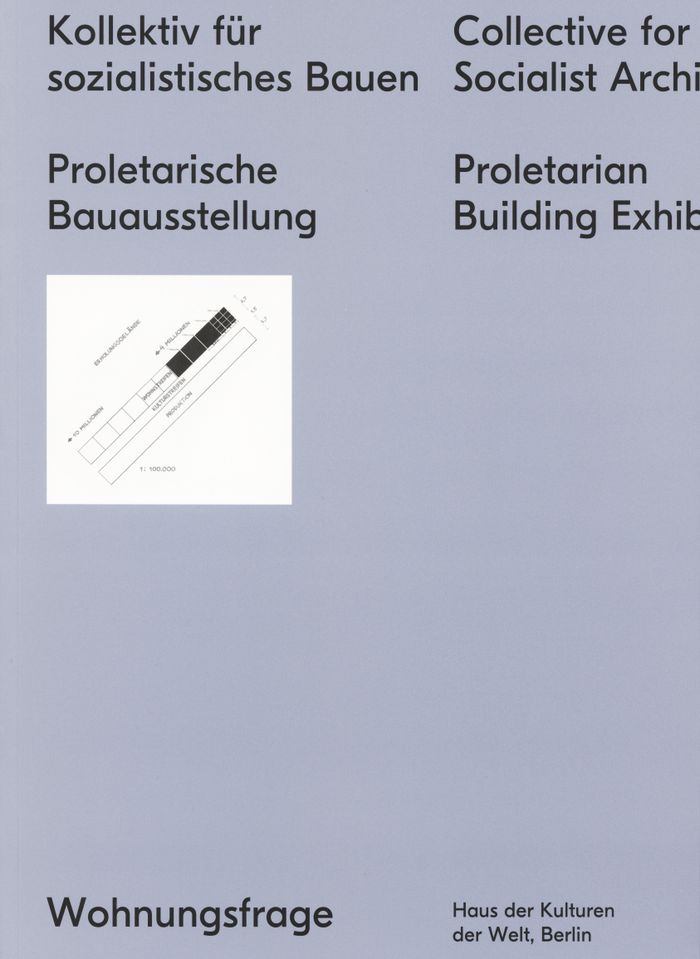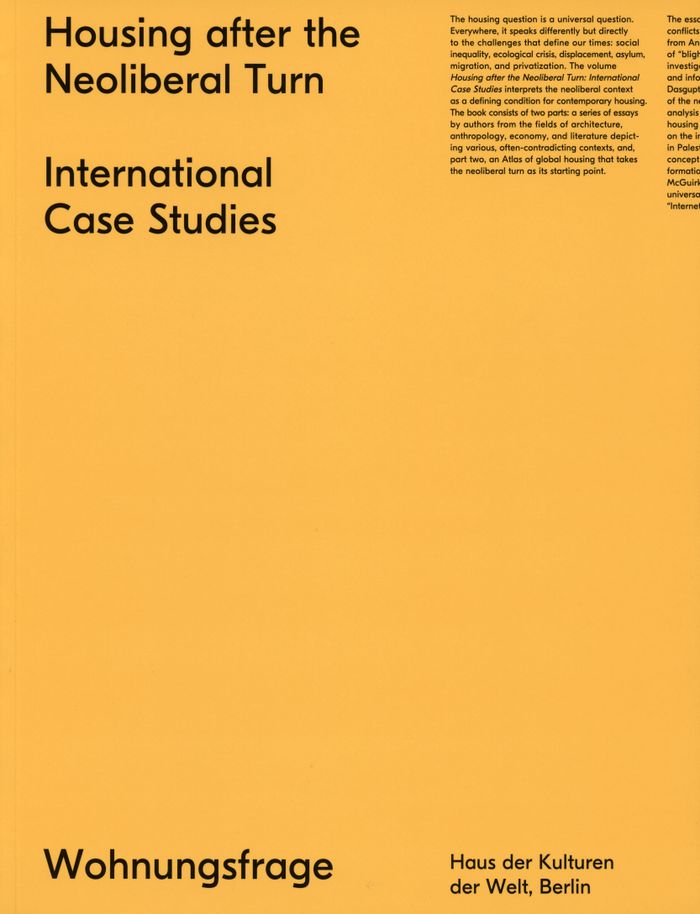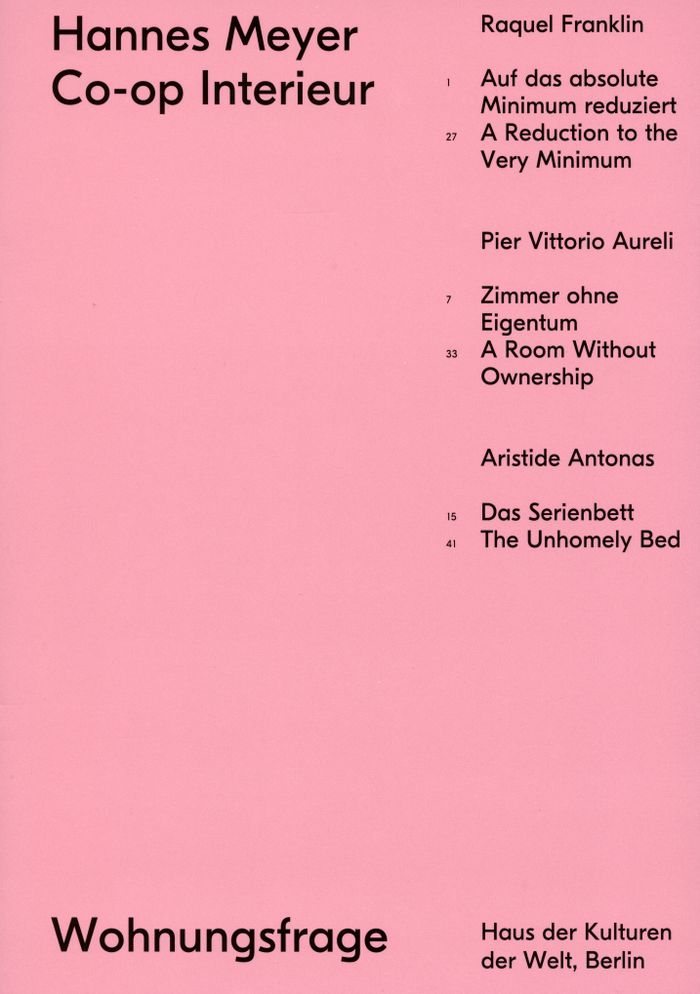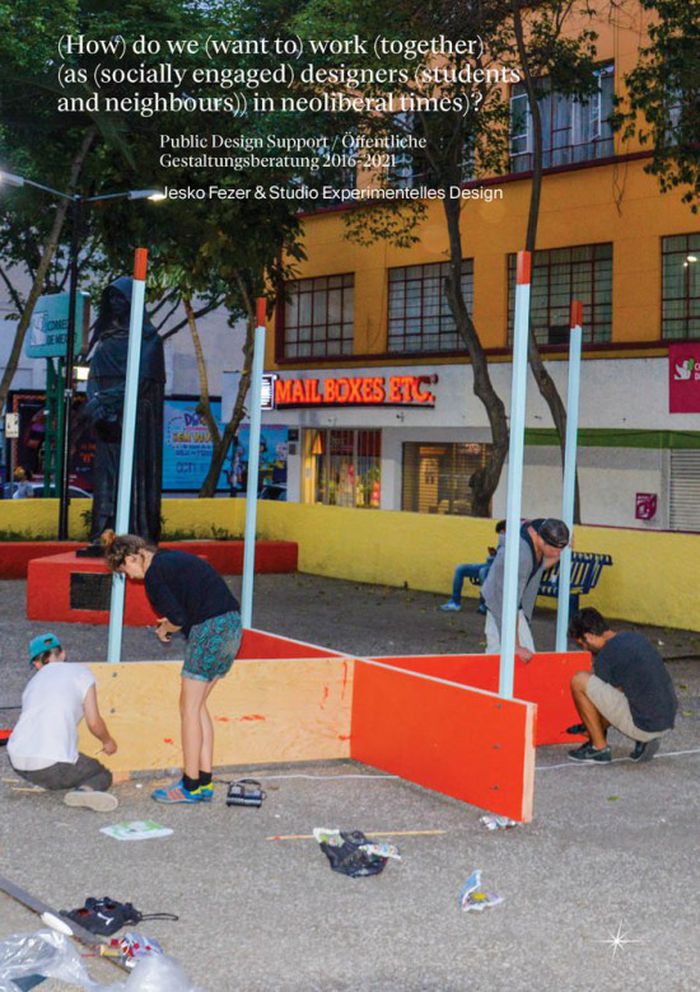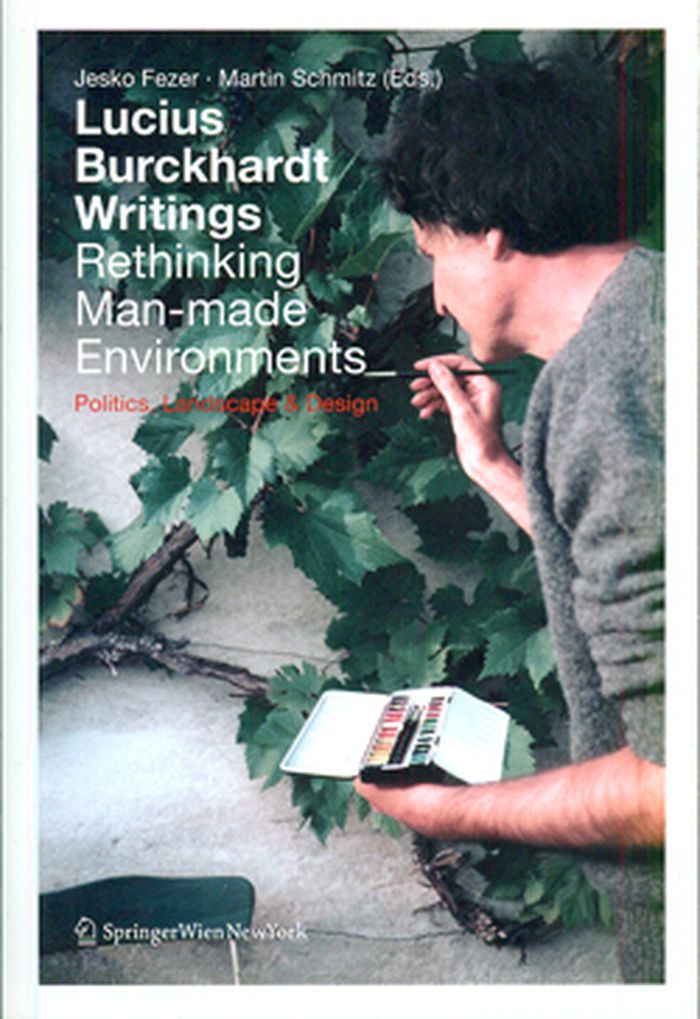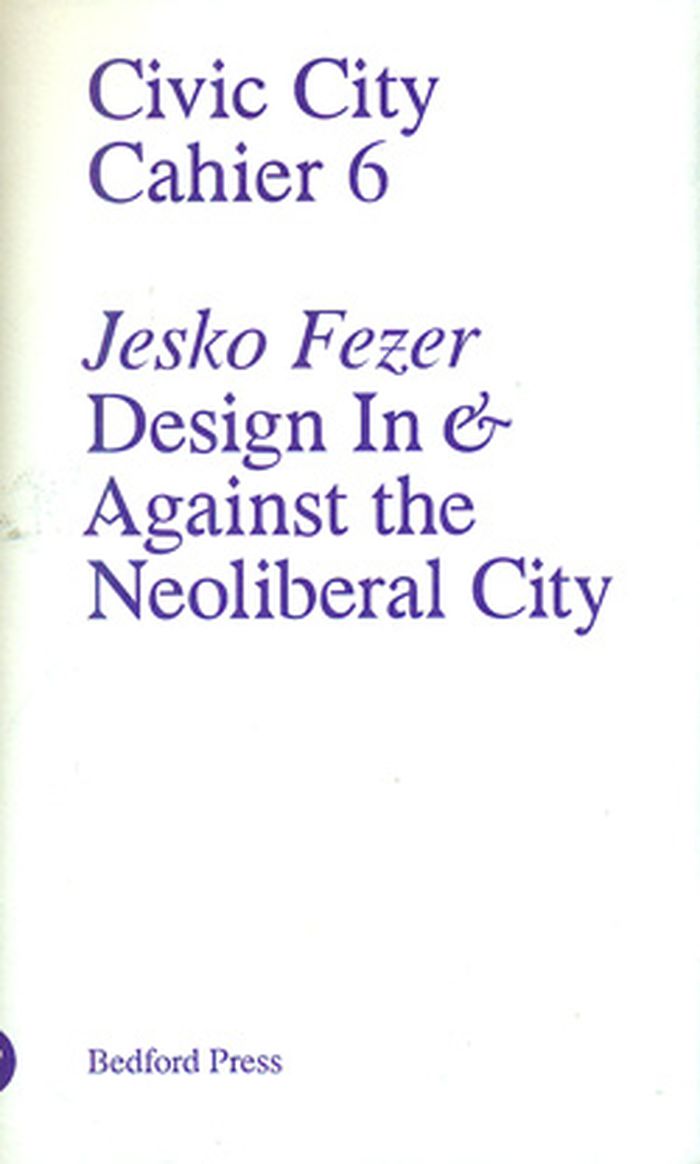$59.95
(available to order)
Summary:
From the 1950s, Lucius Burckhardt (1925-?2003) focused on planning, design, and construction in a democracy. His astute observations and critical analysis have had a fundamental effect on the design of our environment, on teaching in the architectural/planning professions, and on our understanding of what "city" means. His research, which ? between mighty commercial(...)
Urban Theory
February 2020
Who plans the planning: architecture, politics, people
Actions:
Price:
$59.95
(available to order)
Summary:
From the 1950s, Lucius Burckhardt (1925-?2003) focused on planning, design, and construction in a democracy. His astute observations and critical analysis have had a fundamental effect on the design of our environment, on teaching in the architectural/planning professions, and on our understanding of what "city" means. His research, which ? between mighty commercial interests and conflicting political aspirations focuses on the benefit for the entire population ? is indispensable when and wherever buildings are planned, designed, built, and inhabited. With a new selection of texts, this book ploughs a furrow through Lucius Burckhardt'?s theory of planning.
Urban Theory
$12.00
(available to order)
Summary:
A collection of essays of Martin Pawley in Chile (1972)
Martin Pawley's garbage housing with preconsumer waste and the 2cv fourgonette construction system, chile 1972
Actions:
Price:
$12.00
(available to order)
Summary:
A collection of essays of Martin Pawley in Chile (1972)
Green Architecture
$60.00
(available to order)
Summary:
In 1931, in response to the Great Depression and subsequent collapse of the building industry, Martin Wagner (1885–1957), then head of planning for Berlin, formulated plans for an adaptable micro-house called “the growing house.” Working with Egon Eiermann, Walter Gropius, Ludwig Hilberseimer, Erich Mendelssohn, Hans Poelzig and Hans Scharoun, the growing house was(...)
Collective Housing
June 2016
Martin Wagner: the Growing House / Das wachsende Haus
Actions:
Price:
$60.00
(available to order)
Summary:
In 1931, in response to the Great Depression and subsequent collapse of the building industry, Martin Wagner (1885–1957), then head of planning for Berlin, formulated plans for an adaptable micro-house called “the growing house.” Working with Egon Eiermann, Walter Gropius, Ludwig Hilberseimer, Erich Mendelssohn, Hans Poelzig and Hans Scharoun, the growing house was designed to be modified with the changing socioeconomic circumstances of its inhabitants, providing only what was necessary and expedient. Wagner’s coruscating foreword outlining his proposals for a new social, technical and economic fabric shifting the dwelling to the center of the world is published here for the first time. Historical and contemporary black-and-white and color illustrations, drawings, plans and photographs of the prototype are accompanied by commentary from Franziska Bollerey, Ludovica Scarpa, Tom Avermaete and Tatjana Schneider, demonstrating that the growing house is as relevant today as it was 100 years ago.
Collective Housing
$44.00
(available in store)
Summary:
In an empty factory unit tucked away in Berlin’s Köpenicker Strasse, The Proletarian Building Exhibition was mounted with the humblest of resources in 1931. It marked the first action by a group of revolutionary architects, builders, and students forming the Kollektiv für sozialistisches Bauen under the architect Arthur Korn. Taking aim at modernist architects(...)
May 2016
Collective for a socialist architecture: proletarian building exhibition 1931
Actions:
Price:
$44.00
(available in store)
Summary:
In an empty factory unit tucked away in Berlin’s Köpenicker Strasse, The Proletarian Building Exhibition was mounted with the humblest of resources in 1931. It marked the first action by a group of revolutionary architects, builders, and students forming the Kollektiv für sozialistisches Bauen under the architect Arthur Korn. Taking aim at modernist architects participating in the German Building Exhibition and CIAM, they cast architecture as an instrument of power, questioned capitalist solutions to the housing question, and unveiled planning approaches imported from the then-Soviet Union. A full facsimile of the exhibition manifesto/catalog and exhibition panels is featured in addition to contributing essays by contemporary architects, writers and educators, and the Collectives’ Annual Report including a proposed work program and statement of intent. Historical photos are interspersed throughout providing a full reconstruction of this significant architectural and sociopolitical event.
$36.00
(available to order)
Summary:
Housing speaks directly to the challenges that define our times: social inequality, ecological crisis, displacement, asylum, migration and privatization. Framing the neo-liberal context as a defining condition of contemporary housing, International Case Studies consists of two parts: a series of essays by authors from architecture, anthropology, economy and literature,(...)
Collective Housing
July 2016
Housing after the neoliberal turn: international case studies
Actions:
Price:
$36.00
(available to order)
Summary:
Housing speaks directly to the challenges that define our times: social inequality, ecological crisis, displacement, asylum, migration and privatization. Framing the neo-liberal context as a defining condition of contemporary housing, International Case Studies consists of two parts: a series of essays by authors from architecture, anthropology, economy and literature, and an “atlas” of global housing that takes neo-liberalism as its starting point. The essays shed light on the challenges and conflicts of contemporary housing production from Andrew Herscher’s research on the politics of “blight” in Detroit to Justin McGuirk’s text on domesticity as data and universal housing questions eclipse by the “Internet of Things.” Conceptualized and compiled by architectural critic-historian Anne Kockelkorn and Columbia professor Reinhold Martin, the illustrated “atlas” presents 33 housing examples rarely seen together and invites readers to think of housing as an unstable constellation evolving within the power relations of territorial processes.
Collective Housing
Hannes Meyer: Co-op interior
$45.00
(available to order)
Summary:
In his Co-op Interieur (1926)—a simple corner of a room known only in a photograph— Swiss architect Hannes Meyer (1889–1954) gave expression to a radical, antibourgeois style of interior. Comprised only of a bed, a lamp, two chairs and a gramophone on a table, he imagined this room for the nomadic urban worker. Through the absence of people, objects and spatial features(...)
Architectural Theory
July 2016
Hannes Meyer: Co-op interior
Actions:
Price:
$45.00
(available to order)
Summary:
In his Co-op Interieur (1926)—a simple corner of a room known only in a photograph— Swiss architect Hannes Meyer (1889–1954) gave expression to a radical, antibourgeois style of interior. Comprised only of a bed, a lamp, two chairs and a gramophone on a table, he imagined this room for the nomadic urban worker. Through the absence of people, objects and spatial features as much as by the distinctiveness of its design, Meyer was proclaiming an alternative principle for housing, proposing that architecture and design were intended not to fulfill historically determined needs but to overcome their constraints. Historical photographs of the interior and three provocative essays on ownership, minimalism and the “unhomely,” by Brussels-based architecy Pier Vittrio, Mexican architect Raquel Franklin, and Gree architect Aristide Antonas, respectively, explore the layers of meaning within Meyer’s mise-en-scène manifesto on collectivity and utility as a counterpoint to ownership and private property.
Architectural Theory
$35.00
(available to order)
Summary:
Since 2011, the Studio Experimentelles Design at the University of Fine Arts in Hamburg has experimented with local design support as a contemporary practice. The student-led program advocates a community-based, cooperative approach to design. In the summer of 2020, the Kunstgewerbemuseum Berlin Design Lab #6 hosted Studio Experimentelles Design's eponymous online(...)
March 2022
(How) do we (want to) work (together) (as (socially engaged) designers (students and neighbours)) (in neoliberal times)?
Actions:
Price:
$35.00
(available to order)
Summary:
Since 2011, the Studio Experimentelles Design at the University of Fine Arts in Hamburg has experimented with local design support as a contemporary practice. The student-led program advocates a community-based, cooperative approach to design. In the summer of 2020, the Kunstgewerbemuseum Berlin Design Lab #6 hosted Studio Experimentelles Design's eponymous online research festival.” Divided into two parts, this compendium chronicles the studio’s politically and socially committed approach through lectures, research, conversations, and project documentation from the online festival and five years of studio work. Both the festival's debate about working conditions and the studio's practice critically examine the imperative of committed designers today to radically reorient their approach, the content of their work, and their relationship with the actors for whom they design.
$34.95
(available to order)
Summary:
Design for a democratic society was a matter of urgency in bombed-out postwar Europe. Swiss sociologist, journalist, professor and founding father of strollology, Lucius Burckhardt (1925-2003) pioneered the interdisciplinary analysis of man-made environments, and thereby highlighted both the visible and invisible aspects of our cities and social relations. Acutely aware(...)
Architectural Theory
October 2012
Lucius Burckhardt writings: rethinking man-made environments
Actions:
Price:
$34.95
(available to order)
Summary:
Design for a democratic society was a matter of urgency in bombed-out postwar Europe. Swiss sociologist, journalist, professor and founding father of strollology, Lucius Burckhardt (1925-2003) pioneered the interdisciplinary analysis of man-made environments, and thereby highlighted both the visible and invisible aspects of our cities and social relations. Acutely aware of how our interventions and decisions shape the world, and how the changing world in turn, shapes us, his life-long focus was not only the prerequisites of architecture, urban planning and design but also their long-term impact. Teaching and practice still owe much to his work. Thus, the first selection of Lucius Burckhardt's texts to appear in English, introduces his groundbreaking theory of environmental design, in retrospective tribute to a prescient thinker.
Architectural Theory
$21.00
(available in store)
Summary:
Global cities (and their designs in particular) have rested on the paradigm of market-driven development, and have been interpreted as strategic spaces of neoliberal restructuring. Whilst they are now hit by the crisis of this ideology, the situation also offers the opportunity and necessity to imagine another, more social city. Yet designers continue to hold back(...)
Civic city cahier 6: design in & against the neoliberal city
Actions:
Price:
$21.00
(available in store)
Summary:
Global cities (and their designs in particular) have rested on the paradigm of market-driven development, and have been interpreted as strategic spaces of neoliberal restructuring. Whilst they are now hit by the crisis of this ideology, the situation also offers the opportunity and necessity to imagine another, more social city. Yet designers continue to hold back criticism and proposals. It is, however, time to redefine the role of design for a social city and take action. What is the role of design in the production of urban space? Is it merely an element in the commodified colonisation of social spaces? Or are design and the visual and physical representations of urban issues themselves the key means by which a Civic City may be created from the ideological ruins of existing urban spaces? Jesko Fezer argues for a project of accommodating conflicts by design.
